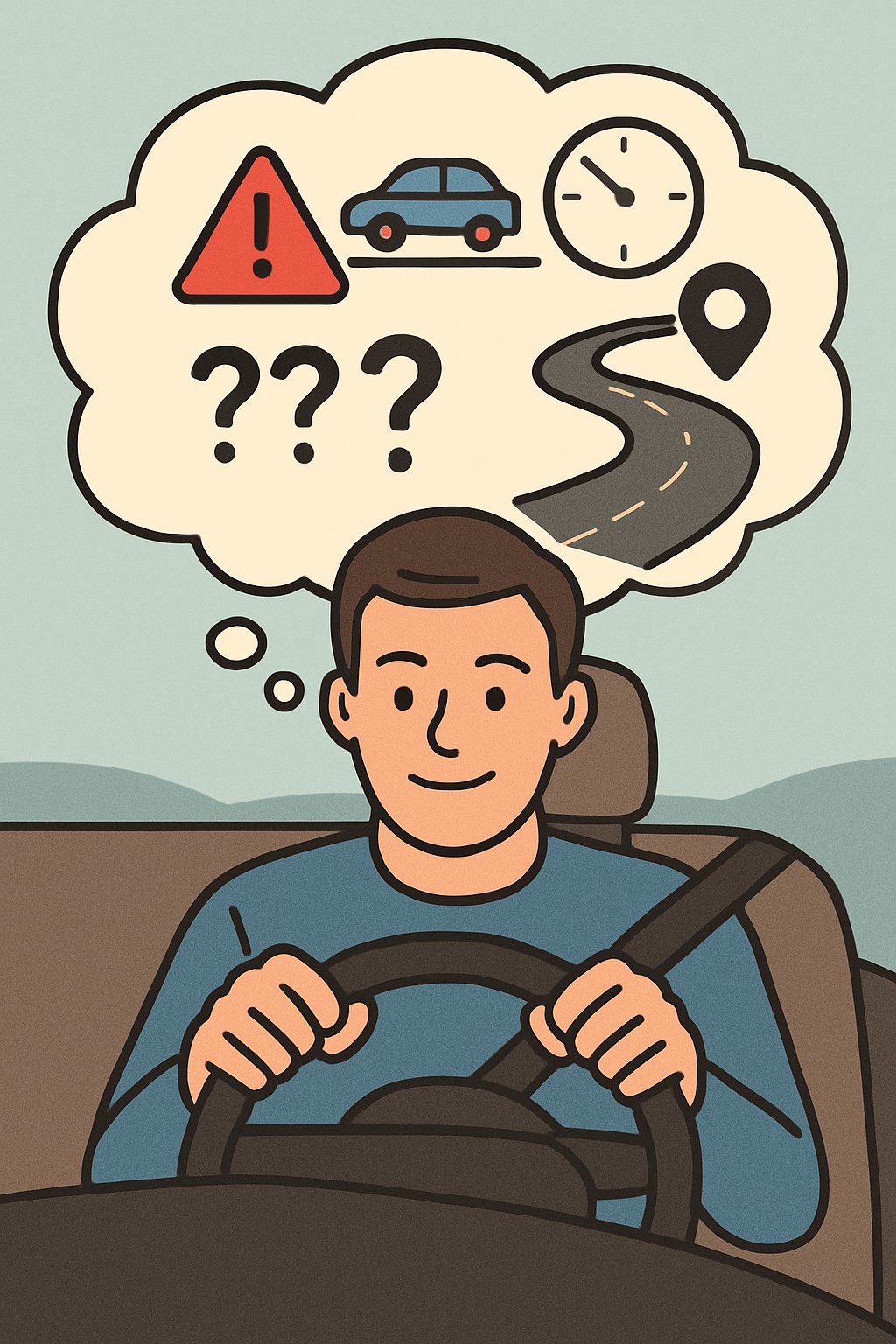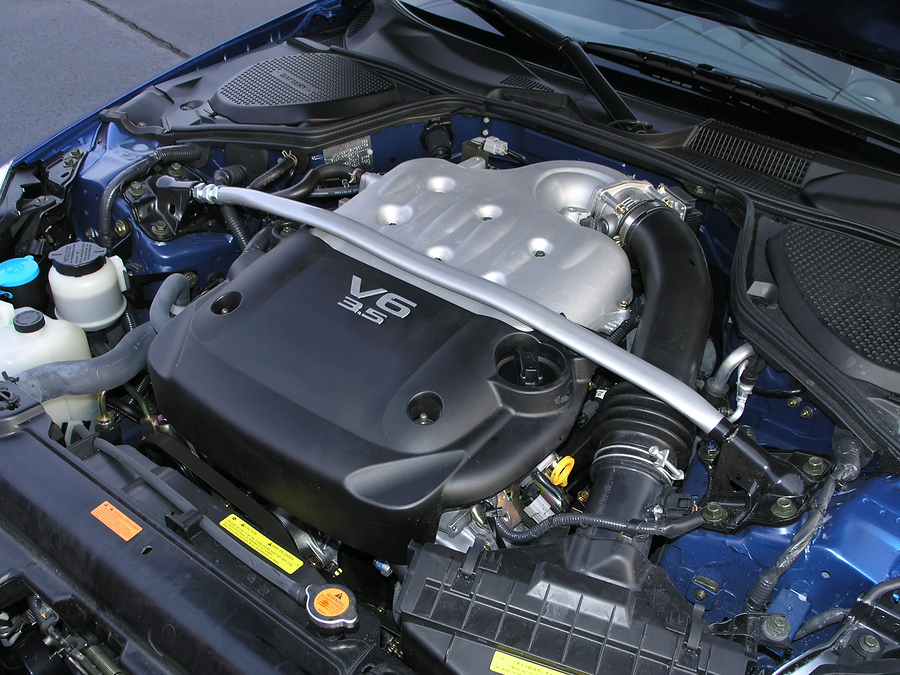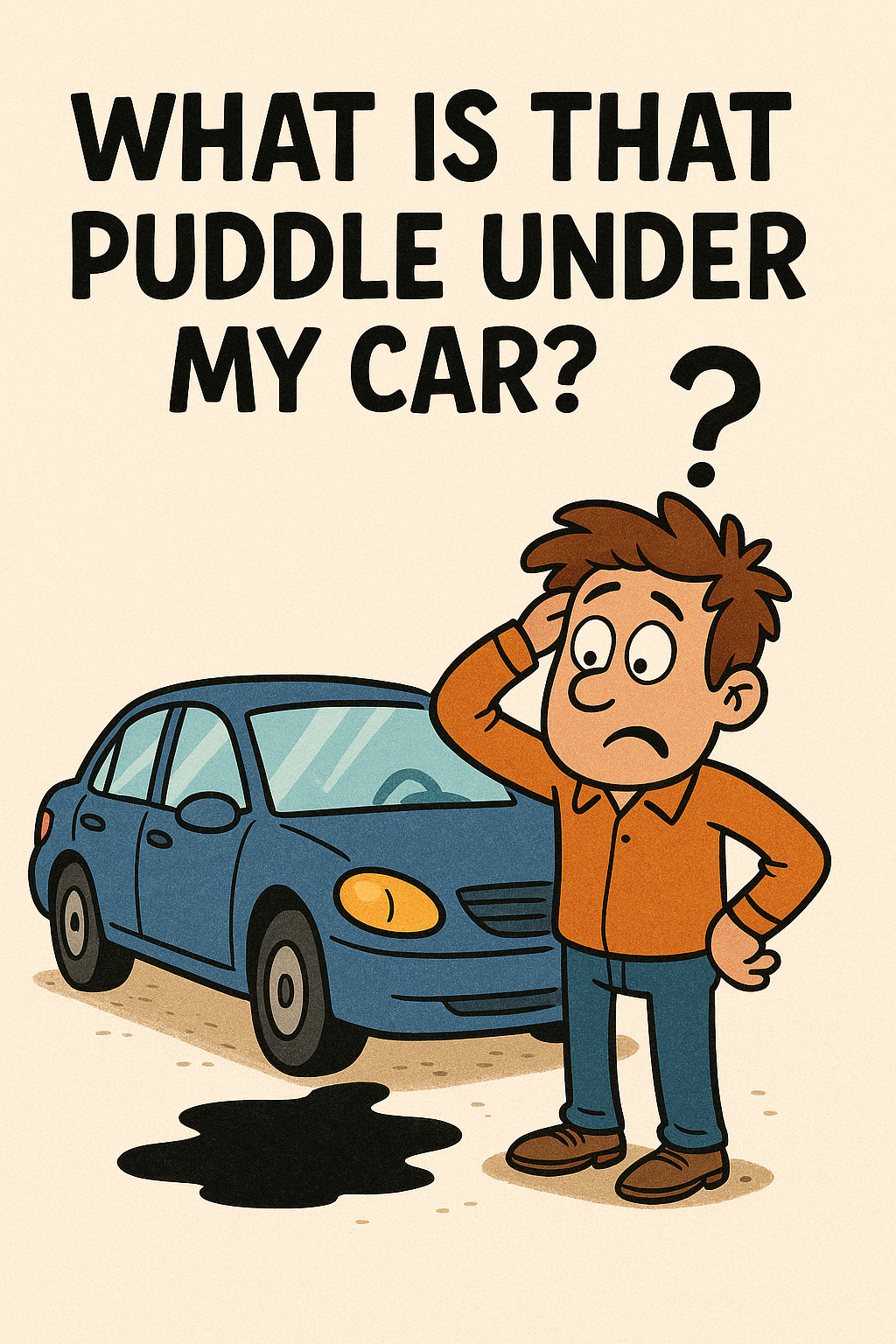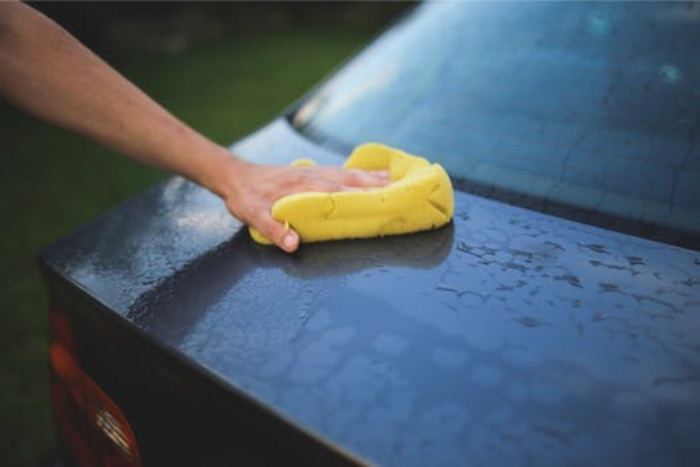NHSA Blog

How Can I Stay Focused on Driving?
Your hands are on the wheel, your eyes are forward, but your brain is off reminiscing about your favorite vacation spot. There is no one in the vehicle to talk to. So how do you stay focused behind the wheel? Some like to run math calculations in their head, figuring out exactly how long it will take them to reach a certain milepost. However, if you are averse to math, here are some mental exercises that might help.
The “Spot the Silly Thing” Game
Pick something harmless but oddly specific, like yellow mailboxes or bumper stickers with puns. Every time you see one, award yourself 10 points. Your brain stays alert and entertained, and you might discover the world is full of strange decorations you never noticed.
The “Secret Agent” Scan
Pretend you’re a spy whose mission is to assess everything within your surroundings.
- Mirrors? Check.
- Blind spots? Clear.
- Car next to you with 17 stuffed animals in the rear window? Highly suspicious.
Keep the monologue going. Remember, no one is listening. This playful mindset keeps your eyes moving and your attention sharp.
The “What’s That Person’s Story?” Trick
At a red light, glance (briefly!) at the driver next to you and imagine their backstory.
- Are they a dentist on their way to a secret ukulele club?
- Are they practicing a speech?
- Are they some oddball using mental tricks to stay focused?
Staying focused doesn’t have to feel like a chore. Mix in a little humor, a little imagination, and a few mental games, and suddenly your brain has something fun and safe to chew on while you drive.
At NHSA, our goal is to help drivers of all ages become confident, safe, and informed. Whether you’re a teen earning your learner’s permit or an adult taking a defensive driving course, we’re here to help you stay safe and smart behind the wheel.

Florida has made changes to its driver education requirements for teens. For many years, ALL first-time drivers, regardless of their age, had been required to complete the 4-hour Traffic Law and Substance Abuse Education (TLSAE) course. Florida recently passed a new law that will now require teens under 18 to complete a new 6-hour DETS course instead of the traditional 4-hour TLSAE course.
For Teens Under 18:
- As of August 1, 2025:
Only Our New 6-Hour DETS Course will be accepted.
For Anyone 18 or Over:
No changes apply to you. You can continue to take Our 4-Hour TLSAE Course.
Why the Change?
Recent updates to Florida Statutes § 322.095 and § 322.1615 require a more comprehensive course aligned with the Florida Department of Education’s Traffic Safety–Classroom 1900300 framework. This change aims to better prepare teen drivers and reduce crash risks on Florida roads.

6 Ways to Teach Your Children About Safety Near the Roadway
As families, one of our most important responsibilities is teaching our children how to stay safe—especially when they’re near roads and traffic. Whether walking to school, riding a bike, or simply playing outside, understanding roadway safety can prevent accidents and build lifelong awareness. Here are some practical tips to help you teach children the importance of staying safe near the roadway.
- Start early with the basics: Even toddlers can begin learning about road safety. Teach them to always stop before stepping off a curb, look both ways, and listen for cars. Turn this into a routine each time you cross the street together. By repeating these habits, they’ll naturally start doing them on their own as they grow older.
- Set the example: Children learn best by watching you. Always use crosswalks, obey pedestrian signals, and put your phone away when crossing the street. If you’re holding their hand and explaining your actions as you go, it reinforces what safe behavior looks like in real life.
- Set rules for playtime: Remind kids never to play near the street—even if a toy rolls into the road. Establish clear boundaries for where they can play safely. For younger children, visual markers like cones or chalk lines can help them understand their safe zones.
- Teach bike and scooter safety: Once your child starts riding a bike or scooter, make sure they wear a properly fitted helmet every time. Teach them to ride on the right side of the road, signal turns, and stop at intersections. Encourage bright clothing or reflective gear, especially in low light.
- Explain the dangers in simple terms: Instead of scaring them, help kids understand why these rules matter. Explain that cars can’t always stop quickly, and drivers may not see small children right away. The goal is awareness—not fear—so they learn to respect traffic without feeling anxious about it.
- Practice together: Go on “safety walks” where you point out signs, crosswalks, and safe walking routes. Ask your children questions like, “Is it safe to cross here?” or “Which direction should we look first?” Making it interactive helps them remember and apply what they learn.
By teaching roadway safety early and reinforcing it often, you’re helping your children develop confidence and responsibility when they’re near traffic. These small lessons today can make a big difference in keeping them safe for years to come.
At NHSA, our goal is to help drivers of all ages become confident, safe, and informed. Whether you’re a teen earning your learner’s permit or an adult taking a defensive driving course, we’re here to help you stay safe and smart behind the wheel.

Taking Your Dog on a Road Trip
In this article, we are going to be focusing on dogs! Almost 90% of dog owners have brought their dogs on a road trip with them at some point.
Very few things make dogs more excited than saying “road trip" (except maybe the word "treat”). Visualize them getting excited by jumping all around you, barking, and wagging their tail. Next they are staring at the door and then staring at you. Their eyes are saying "Let's go right now!"What they don’t realize is that there is much to do before the road trip starts.
Questions to answer before you decide to go on a road trip with your dog
- It is very important to make sure that your dog is ready for a trip.
- Are they healthy enough to travel long distances?
- Do they get motion sickness or get highly anxious when in a vehicle?
- Are their vaccination records up to date?
- Are they microchipped in case they get lost?
Tip: If your dog gets anxious while in the vehicle, take short drives to fun places. Why? So they don’t just associate getting into the car with just going to the vet. Make sure these short trips are places like the beach, boating, or a dog park.
Note: If you bring them to the Starbucks drive-thru, ask for a pup cup. (These are free dog treats.)
If you’re planning a long road trip
Make sure that you find hotels that will accept pets. Most hotels will accommodate you, and they will most likely get you a room on a lower floor of the hotel. They do this because it is easier to take your dogs for a walk outside. You can use apps to find pet-friendly hotels and restaurants such as BringFido.
Make sure to research locations for rest stops so that you can easily pull off the road so that your dog can get a little exercise. Interstate highways are typically the best route to take, with frequent rest stops along the way.
Locating dog parks would also be a good idea. Make sure that the dog park you take your dog to is a public one. There are private dog parks that will not let your dog in unless it is a part of an association or requires you to call ahead to use the park. Apps such as Sniffspot allow you to find dog parks near you.
Don't forget your pup's packing list
- Enough dog food to get to your destination
- Water and a collapsible rubber bowl
- Your dog's medication or something to calm them down (calming aids)
- Vehicle harness
- Leash and harness for walking
- Favorite chew toy or blanket
- Poop bags
Happy travels!
At NHSA, our goal is to help drivers of all ages become confident, safe, and informed. Whether you’re a teen earning your learner’s permit or an adult taking a defensive driving course, we’re here to help you stay safe and smart behind the wheel.

Tips to "Soup-Up" Your Car
Are you a gearhead who loves thinking about ways to make your car look and perform better? Do you dream about building a ride that shows off your personality? Whether you’re just starting out or planning your next big project, here’s how to safely and smartly “soup up” your ride.
Acceleration and Speed Upgrades
Want more power and speed? Some cars are especially good for engine upgrades, including: Toyota Supra (Mk IV), Lexus IS 300 (2000–2005), Nissan Skyline GT-R, Subaru Impreza WRX STI, BMW 3-Series (E36), Mazda MX-5 Miata and RX-7, Mitsubishi Lancer Evolution, Ford Mustang, Ford Focus, and Volkswagen Beetle.
Turbocharging or supercharging : Both turbochargers and superchargers push extra air into the engine, giving you faster acceleration and higher performance.
If you install a turbo or supercharger, you’ll also need to upgrade your:
- Fuel system: Bigger pump and injectors to feed more fuel.
- Cooling system: Radiator and intercooler to prevent overheating.
- Engine parts: Stronger pistons and rods for higher pressure.
- ECU tuning: Adjusts the car’s computer for the new setup.
- Brakes and suspension: To safely handle the added power.
- Transmission: Upgrades to handle the extra torque.
Cold Air Intake: A cold air intake brings cooler air into the engine, helping it burn fuel better and sound sportier. Be careful — if installed incorrectly, it can let in dirt or water, damaging the engine.
If you install a cold air intake, also include:
ECU tuning for better airflow and fuel control, reusable or high-flow air filters for cleaner air, and performance spark plugs for stronger ignition.
Transmission Upgrades: Delivers power from the engine to the wheels — and it needs to be strong enough for your new performance setup. Recommended upgrades include: a performance clutch (manual) or shift kit (automatic), transmission cooler to prevent overheating, and reinforced gears or torque converter for durability
If you upgrade your transmission, also include:
Stronger engine mounts, heavy-duty driveshafts and axles, reinforced differential for even power, upgraded brakes and rotors, and ECU tuning to make everything work together.
Pro Tip: To stay safe and avoid damaging your engine and/or transmission, always have a trained mechanic or someone with a lot of experience make these upgrades. And remember — having more power means burning more gas, doing more maintenance, and paying higher repair costs.
Handling and Suspension Upgrades
If you care about control and cornering, handling upgrades are key. Great handling cars include: Mitsubishi Lancer Evolution, Honda S2000, Nissan Skyline GT-R, Mazda MX-5 Miata, Subaru WRX/WRX STI, Volkswagen Beetle, and BMW 3-Series (E36).
Popular Handling Mods:
- Suspension kits for comfort and control
- High-performance shocks and struts for stability
- Sway bars and bushings to reduce body roll
- Spoilers and diffusers to improve traction
- Strut tower brace for sharper steering
- Performance brakes (larger discs, carbon-ceramic options)
- Performance tires — smaller wheels and thicker tires grip better (stay within one inch of the factory wheel set-up to avoid the need for suspension mods)
If you upgrade your suspension system, also include:
A professional wheel alignment, checking tie rods and ball joints for accurate steering, replacing old shock mounts to prevent a clunky ride, upgrading to lightweight wheels as well as better brakes to handle cornering.
Done right, these changes make your car corner smoother and feel tighter. Done wrong, they can be unsafe — so always prioritize safety and stability.
Exhaust System Upgrades
Cars that respond well to exhaust upgrades include: Toyota Supra (Mk IV), Honda S2000, Honda Civic, Nissan Skyline GT-R, Mazda RX-7, and Volkswagen Beetle.
Consider: wider or smoother pipes to reduce air resistance, mandrel-bent designs for smoother flow, lighter materials (stainless steel or titanium) for better acceleration, and a tuned sound for a sportier feel.
If you upgrade your exhaust, also include:
A cold air intake, a State-approved performance catalytic converter for reducing emissions, headers or downpipes for added power, and ECU tuning.
Pro Tip: When working on your exhaust system, remember to always check local laws, as some exhaust systems exceed noise or emissions limits.
Aesthetics/Personal Expression Upgrades
For many, car mods are also about style and self-expression. Great cars for aesthetic upgrades include: Honda Civic, Lexus IS 300, Nissan 350Z, Volkswagen Beetle, Ford Mustang, Ford Focus, and Nissan Skyline GT-R.
Practical Upgrades with a “Wow” factor:
- LED headlights and taillights for increased visibility (check legality)
- Alloy wheels for lighter weight and style
- Sporty shift knobs and steering wheels
- Legal window tint for glare and UV protection
- Heated seats or custom upholstery/ seat covers
Purely Creative Touches
- High-performance sound and infotainment system
- Underglow and ambient lighting (Some synchronize with the sound system)
- Body kits
- Custom paint, decals, or vinyl wraps
Before you modify:
- Set a budget — upgrades add up fast.
- Test everything carefully before daily driving.
- Buy quality parts that meet your car’s specs.
- Check your insurance — some mods can void coverage.
- Know your local laws — certain mods may be illegal or restricted.
- Choosing the Right Car for Your Skill Level. (For example, Beginner: Honda Civic, Mazda MX-5 Miata/ Intermediate: Subaru WRX / WRX STI, Ford Focus or Mustang/ Advanced: Mazda RX-7)
Have Fun, Be Smart, Be Safe!
At NHSA, our goal is to help drivers of all ages become confident, safe, and informed. Whether you’re a teen earning your learner’s permit or an adult taking a defensive driving course, we’re here to help you stay safe and smart behind the wheel.
Tips for Choosing Between an Electric, a Hybrid, or a Gasoline-powered Vehicle
When shopping for a new car, your priorities—such as whether being eco-friendly, towing heavy loads, or saving money—can make a difference in your choice between an electric, hybrid, or gasoline-powered vehicle. Let's break down the pros and cons of each.
Electric Vehicles (EVs)
EVs run purely on battery power. You plug them in to charge—no gas required. In California, you can also buy a hydrogen fuel cell vehicles (HFCVs/FEVs) but be aware hydrogen fuel is limited even in the Golden State.
Pros:
- Most eco-friendly with the least emissions (the power grid used to charge them may still use fossil fuels)
- Fast acceleration (up to 0-60 mph in 3 seconds)
- Quiet and smooth ride
- Less maintenance required
- In some states, you may qualify for a clean vehicle federal tax credit
Cons:
- Expensive up front and most states require additional fees to register them
- Charging stations can be difficult to find
- Towing heavy loads significantly reduces battery driving range, by up to two-thirds
- Battery replacement is costly (can be tens of thousands of dollars)
Best for: Eco-conscious drivers who like a quiet, smooth ride and don't need to tow often
Hybrid Vehicles:
Hybrid Vehicles use a mix of both gasoline and electricity to varying degrees. Mild hybrids rely more on gasoline, while full hybrids rely more heavily on electric power. Plug-in hybrids (PHEVs) can drive 30–40 minutes on electric power before switching to gas.
Pros:
- Better fuel efficiency compared to gasoline powered vehicles
- Fewer emissions than gasoline powered vehicles
- No battery range anxiety—you can switch to gas whenever needed
- Hybrid batteries usually last longer as the car doesn't rely on the battery alone
- Regenerative breaking extends brake life (sometimes over 100,000 miles)
- Plug-in hybrids may be eligible for a clean vehicle federal tax credit
Cons:
- Still produce tailpipe emissions when using gas
- Higher upfront costs and many states require higher fees to register them
- Plug-in hybrid batteries can be more expensive and complex to replace
Best for: Drivers who want to save money and time charging compared to all-electric vehicles, while also having better gas mileage and lower emissions compared to gasoline engine vehicles.
Gasoline Vehicles:
Within this category you can pick from gasoline engines, Flex-Fuel vehicles (FFVs) which mix gasoline with up to 85% Ethanol (E85), and diesel engines.
Pros:
- Enthusiasts may prefer the feel and sound of the gasoline engine
- Lower upfront costs
- Wider selection of models to fit your style and needs
- Diesel vehicles are great for towing heavy loads and fuel efficiency
- Flex-Fuel vehicles reduce emissions and boost engine performance
Cons:
- Higher maintenance costs
- Not eco-friendly due to tailpipe emissions
- Flex-Fuel ethanol gas stations may be difficult to find (more common in the Midwest)
Best for: Drivers who want a wider variety of affordable or heavy-duty vehicles.
At NHSA, our goal is to provide online driver education that equips all drivers with what they need to be safe drivers. Whether you are a teen seeking a learner's permit, or an adult seeking a driver safety course, check us out online to see what courses are available in your state!

What Is That Puddle Under Your Car?
You walk out to your car, keys in hand, coffee in the other, ready to take on the day. But then—wait a second—what’s that puddle under your car? Uh oh! Not every vehicle lead spells disaster. Identifying the type of fluid and its source can help you determine whether it’s a quick fix or a reason to call your mechanic right away.
The “It’s Nothing, Don’t Worry” Puddle
Usually, this is just condensation (water) from your air conditioning system, especially on hot days. If the liquid is clear and odorless, it’s nothing to worry about.
The “Pay Attention” Puddles
Motor oil – Typically dark brown or black and slick to the touch. Oil leaks often come from the oil pan, valve cover, or gaskets. These should be addressed quickly, since low oil levels can damage your engine.
Coolant/antifreeze – Often green, orange, or pink with a sweet smell. A coolant leak can cause overheating, leading to severe engine damage if ignored.
Transmission fluid – Usually red or pink, but it can darken over time. Transmission issues can be costly, so leaks should be inspected promptly.
Brake fluid – Clear to light brown with a slightly oily feel. Brake fluid leaks are dangerous since they directly affect your ability to stop safely.
Power steering fluid – Similar in appearance to transmission fluid but often found near the front of the vehicle. Leaks here can make steering stiff or noisy.
What You Can Do?
Slide a piece of cardboard under your vehicle overnight to confirm the leak location and amount. Small spots may be okay for now, but growing puddles are your cue to seek professional help quickly.
At NHSA, our goal is to provide online driver education that equips all drivers with what they need to be safe drivers. Whether you are a teen seeking a learner's permit, or an adult seeking a driver safety course, check us out online to see what courses are available in your state!

What are the Maintenance Costs for an Electrical Vehicle (EV)?
If you are shopping for a new vehicle and considering an EV, perhaps you have some questions about the hidden costs.
The EV has been around since the late 1800s. They were not as popular as the gas-powered vehicle back then, because gas prices were so low at that time. The modern EV is much more popular today because… well… gas prices have skyrocketed in recent years. In the late 1800’s the price of gasoline was around $.07 per gallon. Today, gasoline prices vary from $3.00 to over $6.00 per gallon, depending on where you live.
But, of course, operating costs go further than the cost to charge an EV battery or fill the tank in a gas-powered vehicle. What do you need to know about maintenance?
What are the typical maintenance costs of an electric vehicle?
- Because this type of vehicle has fewer moving parts in its engine compartment, the yearly maintenance cost is lower. By some estimates, EV vehicle maintenance costs about $0.06 per mile, whereas gas-powered vehicles cost around $0.10 per mile.
- They also do not require oil changes, transmission fluid, or coolant flushes that are needed in a standard gas-powered vehicle.
- In the case of the braking system, the electric motor assists in slowing down the vehicle, so there will be less pressure put on the brakes and rotors.
- Generally, tires for EVs tend to be more expensive than tires for gas-powered cars, and they may also need to be replaced more frequently due to the unique demands of EVs. They require special tires to handle the added weight of the battery.
- If the battery needs to be replaced, it can cost between $10,000 to $20,000. With that being said, these batteries are meant to last the lifetime of your vehicle, which is up to 20 years. So it is likely the battery will not have to be replaced while you own it. At the end of their use in the EV the battery can be repurposed or recycled.
- If the electrical system has to be replaced, depending on what needs to be replaced, the starting cost is several thousands of dollars.
- Accident repair costs can climb pretty quickly because of the specialized procedures that the mechanic would have to be licensed for. The equipment that would have to be replaced after an accident could also get expensive due to the specialized equipment due to high voltage systems.
Conversation with an EV owner
"Why would you invest in an EV?"
First answer: It does not have an engine that can break down. There is very little maintenance (typically, the only thing that an owner needs to do every 5,000 to 7,000 miles is tire rotation).
Second answer: It is so quiet and they like not having to gas their vehicle up, and they love having the green option. They charge their vehicle at home, which is so much more economical for their busy family.
Third answer: They have three boys and it gives them peace of mind knowing that they are in a very safe vehicle.
Note: Tesla currently has a Five Star Crash Test Rating. All EVs also have high crash test ratings.
So now that you have been given some highlights on EV maintenance, you have a more educated and well rounded idea of what kind of vehicle you might want to buy next time you are in the market.
At NHSA, our goal is to provide online driver education that equips all drivers with what they need to be safe drivers. Whether you are a teen seeking a learner's permit, or an adult seeking a driver safety course, check us out online to see what courses are available in your state!

Making the Most of Your Road Trip on the I-95 Corridor
Your next adventure is driving the I-95, from northern Maine to the tip of Florida. What attractions merit a visit? Which restaurants are highly rated? Which hotels are pet friendly or have stations to charge your electric vehicle (EV)? Come take the journey with us!
Maine
Maine is best known for Arcadia National Park and its rugged coastal line. A highlight is Old Orchard Beach. Enjoy Maine's buzzing food scene at Twin Swirls in Portland, Village Tavern in Kennebuck or Min Suchi and Ramen Bowl in York. To charge your (EV), stay at the Comfort Inn in Augusta.
New Hampshire
New Hampshire means the White Mountains. Other popular excursions include Albacore Museum and Water Country Water Park. For good food, try the Green Elephant with its full vegetarian menu, Bob's Broiled Chicken Restaurant, or Nikki's Banh Mi. Charge your EV at the Port Inn in Portsmouth.
Massachusetts
Boston is the heart of MA, and with a quick jump to I-93, you'll find yourself right at its pulse. Visit the New England Aquarium, Fenway Park, Faneuil Hall Marketplace on the Freedom trail, and Isabella Stewart Gardner Museum. Foodies recommend Cal's Brick Oven Pizza and Cal's Creamery in Reading, Dunn-Gaherins Food and Spirits in Newton, and Wicked Tea and More in Walpole.
Rhode Island
Rhode Island's beautiful coastal towns include the Cliff Walks in Newport. Also visit the RISD Musem and Roger Williams Park Zoo in Providence. Local hotspots are the Souvlaki Zone in Providence and Vanda Cucina in Warwick. Get off at Exit 1 for Hopkington P+R or Exit 10 at Warwick P+R to charge your EV for free.
Connecticut
Connecticut tourists often visit the Yale Visitor Center, Gillette Castle State Park for boating or hiking, Mystic Seaport Museum, and Mystic Aquarium. Local eateries include Two Roads Brewing in Stratford, Shayna B's by the Sea in Westbrook for GF and Vegan options, and Frank Pepe Pizzeria in New Haven.
New York
The Big Apple! The outskirts of NYC offers nature-lovers the NYC Cloisters Museum and Gardens. To visit Manhattan but avoid city traffic, purchase a Groupon ahead of time for parking. Use OMNY on your smartphone to tap-to-pay your fares on MTA buses and subways. Once in NYC, catch a game at Yankee Stadium, walk through Central Park, or watch a Broadway show. New York is famous for its sandwich and pizza joints, including Katz Deli.
New Jersey
Many visit the Jersey Shore. Excursions also include New Jersey's Bamboo Forest in New Brunswick and Mitsuwa Marketplace in Edgewater. Local eateries include the HMart Eatery Food Hall in East Rutherford and 504 Grill and Gyro in Perth Amboy. Charge your EV in Trenton, Cranbury, and East Brunswick.
Pennsylvania
Pennsylvania, "the Keystone state". Check out Richmond Longwood Gardens in Kennett Sq., Independence Hall, or the Automotive Museum in Philadelphia. Take a trip to Shay's Steaks, Lucy's Smokehouse, or Queen and Rook Game Cafe for vegan and GF food. Stay at the Sheraton in Philadelphia to charge your EV.
Washington, D.C.
If you visit the Capitol, popular attractions include the White House, National Mall, Lincoln Memorial, Library of Commerce, Smithsonian Museums, and the Capitol One Arena to catch an event. To eat at a historical landmark, try Old Ebbit Grill. Otherwise, use I-495 to avoid D.C. and its traffic completely.
Maryland
Maryland is famous for blue crab and the National Aquarium. You can also visit the Edgar Allen Poe House in Baltimore. Famous eateries include 2Fifty Texas BBQ in Riverdale, Chaps Pit Beef in Baltimore, and Crab Trailer in North East. Charge your EV at the Holiday Inn in Jessup or SpringHill Suites by Marriott in Columbia.
Virginia
Enjoy Virginia's beauty at Lewis Ginter Botanical Garden in Lakeside or Belle Isle in Richmond. Experience its history at the Fredericksburg National Military Park. Foodie locations are ZZQ Texas Craft BBQ in Richmond, Huarique Peruvian Cuisine in Woodbridge, and Cuppa Cheer Tea Room in Ruther Glen.
North Carolina
North Carolina is famous for the Blue Ridge Mountains and college basketball. Visit Vollis Simpson Whirligig Park in Wilson. Local recommendations include Coffee on Raiford, Tortilleria y Taqueria Ramos in Smithfield, and Napkins in Hope Mills. To charge your EV, try the local Hilton hotels.
South Carolina
South Carolina's famous beaches include Myrtle Beach and the Grand Strand. Also visit Santee State Park, Bee City and Honey Bee Farm in Cottageville, and South Carolina State Museum in Columbia. Don't miss Buc'cees in Florence, Shuler's BBQ in Sellers (cash only), and Al Chile Mexican Grille in Ridgeland.
Georgia
Visit Forsyth Park in Savannah, Cumberland Island National Seashore in St. Mary's, or Tybee Island Lighthouse and Museum. For southern cooking, try Gary Lee's Market or Buc'cees in Brunswick and Narobia's Grits and Gravy in Savannah. To charge your EV, stay at the SpringHill Suites by Marriott in Savannah.
Florida
Disney! Other fun places include the Kennedy Space Center, Monkey Jungle or Coral Castle in Miami, Butterfly World in Coconut Creek, Busch Wildlife Sanctuary in Jupiter, and Shantytown Shopping Village in St. Johns. Try Starvin like Marvin in Jacksonville or Bella Amici Pizzeri in Boca Raton for vegan options.
Pet-Friendly Hotels with breakfast (under $150)
For pet-friendly hotels under $150, look out for these hotels: Best Western Plus, La Quinta Inn, Rodeway Inn & Suites, Motel 6, Extended Stay America, "by Marriott" hotels, Quality Inn, Super 8, America’s Best Value Inn, Comfort Suites, Ramada, Country Inns & Suites, Days Inn, Red Roof Inn, Econo Lodge, Spark by Hilton, Baymont by Wyndham, Knights Inn, and Red Carpet Inn.
Safe travels!!
At NHSA, our goal is to provide online driver education courses that equip all drivers with what they need to be safe drivers. Whether you are a teen seeking a learner’s permit, or an adult driver seeking a basic driver safety course, check us out online to see what courses are available in your state!

The Pros and Cons of Washing Your Own Vehicle
It may be faster to just pay some money and let the machines do their job. But is that really the best approach? Should you just wash your own vehicle? The following lists of pros and cons may help you to make a decision.
Pros
- Washing your own vehicle will save you money. Depending on where you live, you could pay from $20 to $40 or more per month at the car wash.
- No one is going to want to take care of your car more than you. You will be able to clean it and detail it the way you want to.
- You will have a sense of accomplishment and pride that you can keep your vehicle looking nice.
- If this is your first vehicle, it will show your parents that you are responsible.
Cons
- Depending on where you live, certain times of the year might be too cold outside to wash your vehicle by hand. So you might only be able to wash your vehicle by hand during the warmer months.
- How much does water cost in your area? You could use 10-20 gallons (or more) of water every time you wash your vehicle at home.
- It takes time and planning to wash your vehicle properly.
- It could get muddy around your vehicle if you wash it in your driveway or yard.
Bonus tips, if you decide to clean your own vehicle:
- Use the 2-bucket method to conserve water (one 5-gallon bucket for soapy water and another 5-gallong bucket for cleanse rinse water). Before you start, get that water hose out of the garage and hook it up to the outside faucet for the final rinse.
- Clean the windows and the body of the car using a clean, soft cloth and warm soapy water.
- Use a long-handled brush to scrub the undercarriage and a smaller hand held brush to scrub the fenders. (This will help to prevent rust.)
- If you decide to clean under the hood of your vehicle, lightly clean the top of the engine; do not soak the engine with water.
- You will need at least two large towels to dry your vehicle properly. Make sure you dry your side mirrors and windows first, before they get water spots on them.
- Detail your tires. Once you are finished detailing your tires, don't forget the Armor All to shine up your clean tires.
- Depending on where you live, waxing your vehicle about every three months or so will help protect the paint. This will keep your vehicle looking good for a longer period of time.
Last but not least...have fun washing your vehicle. Enjoy being outside, make some memories, and get into a friendly water fight with those who decide to help you. Your dog will be happy to be outside with you, too. Let them drink from the water hose. Most dogs will love it.
At NHSA, our goal is to provide online driver education courses that equip all drivers with what they need to be safe drivers. Whether you are a teen seeking a learner’s permit, or an adult driver seeking a basic driver safety course, check us out online to see what courses are available in your state!


